Tiberius Aerospace has announced it has secured a UK Ministry of Defence contract to support the rapid trials and development of its Sceptre ramjet artillery round, a new extended-range precision-guided 155mm munition.
According to the company, the contract makes the UK the launch customer for its technology, with verification and validation work supported by the US Defence Innovation Unit. Specific contract details have not been disclosed.
Sceptre, formally designated TRBM 155HG, is described by Tiberius as a “revolutionary” munition able to reach speeds of Mach 3.5, altitudes of more than 65,000 feet, and ranges of up to 150km depending on payload. The round is designed to be compatible with NATO-standard 155mm artillery systems and incorporates a liquid-fuelled ramjet using multiple fuel types. The company claims a circular error probability of less than 5m, even in GPS-contested environments, a major improvement over traditional artillery.
Andy Baynes, co-founder and Chief Strategy Officer of Tiberius Aerospace, said: “Since the launch of Sceptre in May 2025, Tiberius has evolved the capability at pace through a series of high tempo live-firing and synthetic test cycles. We’re delighted to announce this UK MoD contract which has invested early in our technology development cycle. This is testament to the UK’s visionary leadership and their understanding of the importance of driving innovative solutions such as Sceptre and Defence-as-a-Service to increase national security.”
The company says that its approach draws on Silicon Valley practices, with a focus on rapid iteration, agile development, and what it terms “Defence-as-a-Service,” decoupling innovation from manufacturing to support sovereign collaboration and adaptation across allied nations.
Tiberius plans to showcase Sceptre and its broader development model at DSEi in London from 9 to 12 September, where it will also launch its GRAIL platform alongside UK and US defence innovation officials.
Founded in 2022 by Chad Steelberg and Andy Baynes, Tiberius Aerospace says it aims to apply commercial technology expertise to next-generation precision weapons, missile systems, autonomous platforms, and AI-enabled defence capabilities for the UK, US and allied nations.


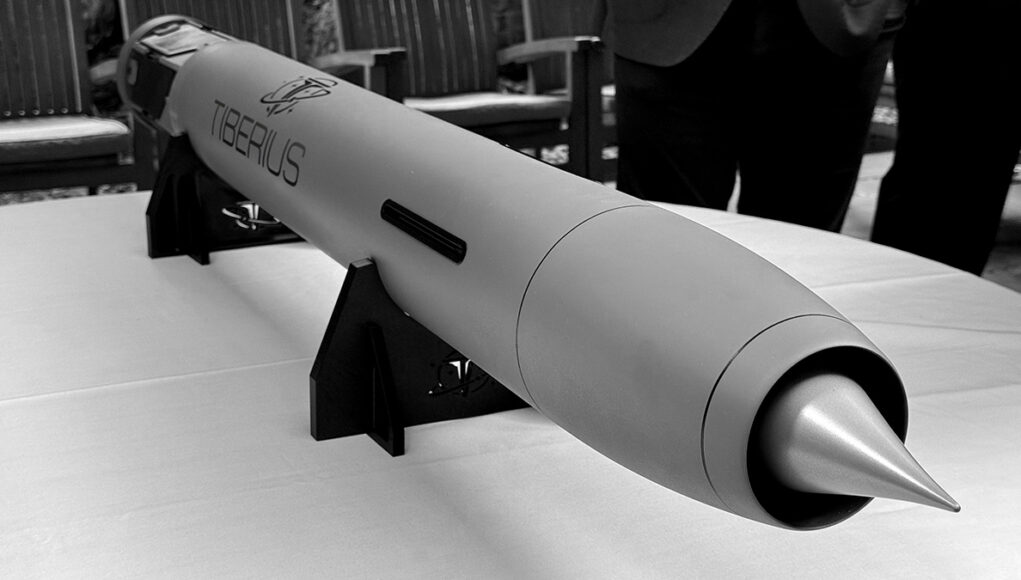
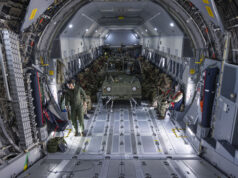



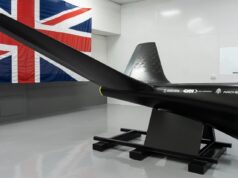


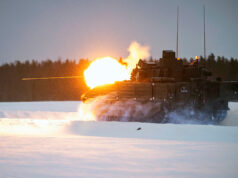

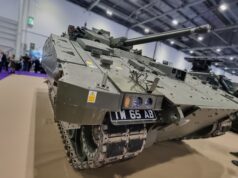

Well Beam me up Spock, James “T” Kirk gets an order from a UK “Enterprise”.
(It’s all I could come up with).
‘Britain contracts tiberius munition’
I know, this sort of trial spending really is a disease.
How’s that, Halfwit?
Very good, I like the cut of your Jib !
Have you seen tghe T83 article on Janes ? It’s interesting, just a rendition but it does look the Dogs.
TGHE, I was using my big toe.
Just sayin like.
Unfortunately not, because a) Janes is blocked on my school laptop for some reason (‘ads’, apparently!) and b) I don’t have the funds to cough up 300 quid a year for some nice online articles.
Is there anything particularly interesting?
Nothing that I can see from the attached infographic – it seems to be much the same as the article posted to Naval News a few months back, combined with the graphic from the Navy Lookout article on the subject.
The price for a Janes subscription is already crazy, but I wonder if you’ve seen just how much their famous annual encyclopedia of ships costs?
I wonder if the site has a login we could borrow? 🙂
*School Laptop” ? I don’t pay, I just read the headlines and look at all the nice pictures ! The Ship Picture just looks rather nice, I know It’s not accurate but It’s the best I’ve yet seen.
LEH, I don’t go on NL apart from when someone here mentions it, also have you a local Library, mine has a great book section and collection of Jane’s stuff. It’s always a couple of years out of date or there abouts but still a good way to kill a few hours.
Yeah, the library is a good shout. Unfortunately my local library is rather small, but I might head into my nearest city and have a look. Thanks for the help!
leh £91 for half a book omg, and it out of date in a year I think I used to pay about £30 in the 90′ think I still have them somewhere they have Broadsword, Amazon, Sheffield, County and Leander-Class
I find that the best place to pick Jane’s copies, albeit old ones, is second hand bookshops. If you’re lucky there can be up to 1990s copies, and my brother has the 1987 edition.
I only have the ‘Fighting ships of WW2’ and ‘Fighting aircraft of WW2’, though I did find a copy of the first edition of Jane’s Surface Skimmers (hydrofoils and hovercraft) this summer at Southampton University.
JFS 2025-2026 is £1,905!!! It’s now solely targeted at government bodies and defence companies. Up to about 2015, Navy Books used to sell heavily discounted surplus copies of the previous edition of Janes Fighting Ships for £200-£300. Expensive, but I would splash out alternate years. Then Janes got taken over by IHS who doubled the list price, then doubled it again, and also stopped all discounting. Old editions are now still sold at their original list price. I keep a lookout, but even a 5 year old copy of JFS on eBay is now more than I can afford. There used to be a much cheaper half alternative in Combat Fleets, but a new English language edition hasn’t been published by USNI since 2012 (and that was a disappointing partial update), so I assume it’s defunct.
You have Jane’s.. my wife would murder me if I got Jane’s..”sob”.
Just the home page, It’s all I really need as I like the headlines and pics !
Interesting to read that both BAe and Babcock will submit designs for the T83. Where BAe are looking at a further (stretched) evolution of the T26, whilst Babcock are looking at an Arrowhead 160.
There are a number of points I’m taking from the BAe design. The first is that they are looking at only Mk41 for the VLS, not Sylver, with a possibility of a further upgrade to the large advanced payload module for hypersonic weapons. Interestingly the Senior Responsible Owner (SRO) for the Future Air Dominance System (FADS/T83) has said they are taking the magazine depth as a critical requirement, where they are looking for up to 128 air defence missiles. Considering the image shows 112 VLS and the ship will still be using something like quad packed CAMM. Then there’s plenty of room for other “effectors”. Which the image shows can be strike or ASW. Where the image shows the ship with a sonar option, which would give it a true multi-role capability unlike the T45 currently.
The second point, is that the SRO has stated that Sea Viper Evolution capability 2 is going ahead. This is the integration of the Block 1NT Aster variant. So the T45 and then the T83 will have a true anti-ballistic missile capability. But will there be further enhancements to match the capabilities that SM6 or even SM3 gives?
The third point is the image states that the RN are considering both laser based and RF based directed energy weapons for CIWS. Where with the Bofors 40 looking weapons, means Phalanx is finally retired (from the future destroyers at least).
My forth point is that they will be using the Bofors 57 as the primary gun system. So it seems Naval Gunfire Support (NGS) will no longer be a realistic option. As the explosive weight of the 57 is pretty ineffectual against hardened targets. But the 57, along with the 40s give the ship a much cheaper alternative at dealing with low cost drones. Just a pity they aren’t going down the 5″ route, which with the hyper velocity projectile (HVP) would have given a significantly better stand-off range against aerial targets. Personally, would have gone down the 5″ route, but also kept the 57, but instead have a pair, with one mounted on the hangar and the other in front of the bridge. Moving the two 40s to either side of the funnel, then moving the “Dragonfire” to either side of the rear VLS farm. I know this would make the ship very gun heavy, but it would give a better all round layered gun defence, as well as allowing the ship to stay in the fight for longer when the ship runs its missile magazines dry. Plus allows the ship to use the 5″ for NGS, or possibly the gun fired sonarbuoys.
My fifth observation is with the radar suite. I welcome the ship having fixed arrays mounted low down on the mast. along with a mechanically rotating radar on top of the mast. As this means the ship still has an extended radar horizon, which is important for early detection of sea skimming missiles. Whilst the fixed panels can be made larger, which allows the radar to generate more transmitter power and receiver sensitivity thereby giving greater detection range. However, like the T45, the ship will have a radar dead zone directly above it. If the radars have a field of view in elevation of +70 degrees from the horizon. Then there is a 40 degree cone above the ship. This can easily be solved by fitting a AESA panel that looks directly up. There have been previous renditions of the T83 that showed this. Which will be critical if faced by more effective ant-ship ballistic weapons.
Overall, the BAe design looks fairly well balanced against the myriad of threats a ship now faces. At last we will no longer have hedgehog warships!
There appears to be an expectation in the RN that the Aster-30 Block 1NT will be integrated into the Mk41 VLS by the time that the destroyers are coming into service. If that is the case, and the effector is maintained through to the Type 83 destroyers, I expect we’ll see further improvements to the missile. It’s generally recognised that the Block 1NT has similar BMD performance to early SM-6 blocks, so there’s room to improve. A larger booster could be considered, for example.
That said, the ideal scenario in my eyes would be a mixture of the Aster (and its future developments) and the multi-packed CAMM and CAMM-MR, which would enable a very high number of interceptors to be carried across a lower (and therefore more compact, less expensive) number of cells. If we take that 128 missile target as a baseline, using multi-packing would allow that to be achieved with just 72 cells, leaving plenty remaining for strike missiles.
But Davey, with respect, I’d warn against making any concrete assumptions purely from the image given. I expect there’ll be significant differences by the time it enters service. BAE, who are building the radar system for design currently, shows no rotating array on their own design, which can be seen in the Navy Lookout article about the programme.
Yes, the images definitely don’t show a finished design.
For example, I worked out when the article was on NL that the extended barrel on the 57mm would give a barrel length of over 120 calibres!
Maybe it’s not a 57mm?
Or an evolved version?
One can always dream!
I’m highly in favour of the ship having two primary radars. If the mechanically rotating one has a pair of AESA panels mounted back to back as per Sampson, but operates in the X-band. The array’s surface area could be made bigger due to the lighter weight, thereby improving the generated power but also the receiver’s sensitivity. Having four fixed panels operating in the S-band also makes a lot more sense. As these can be mounted much lower, as they are predominantly looking above the horizon. Therefore their surface area can be much larger as per the SPY-6 (V1). Giving nearly similar ranges achieved by a L-band radar, such as the S1850M.
The Aster 30 Block 1NT is still quite some ways behind the SM6 Block 1 in regards to the height it can achieve. This is explained by comparing the dimensions of the two missiles. The first clue is that Aster 30 is launched from the 5m deep Sylver A50, whilst SM6 has to be launched from the 7.7m deep strike length Mk41. Aster 30 is 4.9m long whilst SM6 Block 1 is 6.6m long. The SM6 uses this additional length to have a longer 1st stage booster over Aster. Aster could quite conceivably gain additional length for its 1st stage booster, so long as its launched from the longer strike length Sylver A70 or Mk41. With the additional fuel, Aster will accelerate faster for longer, meaning it will reach higher than it can currently.
However, SM6 was based on a boosted SM2, its diameter is much wider than the 2nd stage dart of Aster, i.e. 340mm (Block 1) vs 180mm, the newer Block 2 is 530mm in diameter. Meaning even the SM6’s second stage holds more fuel than Aster’s. However, Aster should be capable of better manoeuvring at the terminal stage due to the mid-body reaction jets. Which I believe uses a separate fuel source. The 1NT will have a much better radar than SM6, unless Raytheon start looking at fitting an AESA radar.
MBDA are making a direct competitor to SM6 (both Block 1 and Block 2), which is the Aquila. This is being designed to engage targets above 150,000ft as per SM6 Block 2. However, it is still in the concept stage and is unlikely to be on trials before 2030, whereas SM6 is available today.
What this means for the T45 in its current state, is that it can’t be integrated with SM6 or SM3, as it would have to have the strike length Mk41 fitted. Even if Aster was given a bigger 1st stage, the Sylver A50 farm would have to be replaced with the A70 or preferably strike length Mk41. If not, the T45 will be limited to engaging short to medium range ballistic missiles.
Why not angle the main radar panels at more than 10° to the horizontal to reduce that 40° zone? If they were at 30° there would be no need for a vertical panel, right?
Hi Jon, beamforming radars use either passive electronically scanned arrays (PESA) or active electronically scanned arrays (AESA), generally have a field of view for elevation of +/- 45 degrees from the centre of the panel’s boresight. To remove the dead zone above the ship, the panel would need to be tilted back to +45 degrees above the horizon. However, by doing this, the negative part of the radar beam, will now be running more or less parallel to the sea (perfect dead calm and with no swell or heave). Meaning that there is a dead zone where the radar cannot see below the beam to the sea.
Most Navies fit their panels to give a positive elevation of 70 degrees. Meaning that the boresight is a positive 25 degrees above the horizon. Which then allows the ship’s radar to look down towards the sea from the ship towards the horizon. There will be a dead zone near to the ship, where the ship has a minimum field of view.
There are three options, that could give the ship the full 90 degrees of elevation coverage. The first is fit two sets of panels on a single heading, but at different elevations. So when combined, they give the full 90 degrees field of view. Another option is to fit a panel into a mechanical gimbal which can then tilt the radar up and down to cover the 90 degrees. The final option is to mount a separate radar panel on a flat upper surface that then looks directly up.
The first option, would be pretty expensive, plus add a lot more top weight to the ship. The mechanical gimbal option is doable, but it will add additional weight. There’s also a fair chance that the gimbal will fail at a crucial moment when it is needed. The fixed panel looking directly up, is the preferred option, as its lighter than including say four mechanisms for four panels. It will also be cheaper than the other two options and its going to be a lot more reliable.
What are the ITAR implication? What level of control do we have will it be made in the UK etc..
Well it sounds good.
All we (the UK) need is some weapons to fire them from.
“(tested through) a series of high tempo live-firing and synthetic test cycles.” Really? Have they got a ready-to-go missile and, if so, where did they test fire it?
Now this is the sort of innovation that we need, if it lives up to what it says on the tin. Now let’s hope the talk leads to substance.
Will the Excalibur and SMArt155/BONUS munitions thereby be deemed obsolete? 🤔 Another topic not w/in my wheelhouse. 🙄
Smart 155 and Bonus are specifically anti-armour weapons, so there’s no overlap. Excalibur won’t be able to compete on range, but may be cheaper and have a larger explosive payload. Ramjet rounds probably have a large minimum range as well.
Thanks for the info and rapid response! 👍😊
Also ramjet rounds will be expensive and have a low production rate (even compared to smart guided rounds which are already more expensive and have longer lead times than conventional munitions). If this goes ahead this will be a small stock reserved for high priority targets probably at the discretion of *** targeting.
When do we get the 155mm Guns to fire them from?
Type 26 …. in about 3 years we get the first.
This would be one hell of a good capability if it is highly accurate/guided which i am sure it will be.
I think the Type 26 frigate will be equipped with the MK45 5-inch (127mm) naval gun system
Ops list the plot las I know this lol
😂
Ha, not sure about that as T26 has a 5 incher ! but stick a few 155’s on deck and jobs a good’n, It wouldn’t be the first time RN ships had Archers !!!
Rather famously the size of a toothbrush.
Well we do have them..just not very many.
The RCH-155s are on order, up to 400 in total for U.K. and Germany. Germany says it wants 160 which means…
I’ll believe that when I see one at the RSA on trial
The only person who needs to know about your trust issues is your life-partner, if you have one.
As I said I’ll believe it when RATDU are playing with one at RSA and I do have a life partner
Agreed, David.
And do they know of your trust issues?
When were they ordered? do have link to that story? and the UK wants 96/116. You must have insider information as no order has been made just an agreement to develop the system. Ukraine is the only user so far. Happy to be corrected with facts any time. HQ DRA knows nothing about an order.
Wow 2025 and someone doesn’t know how to use Google and relies on being spoon-fed by others…
BTW you must be new here, as any comment with a link goes into ‘pending approval’ purgatory never to be published…
They are on order. But not paid for. Delivery begins sometime in 2050 and will be completed in 2075. Courtesy of HMG.
Don’t have money for defence but happy to spend £15 million a month housing illegal economic migrants in hotels
Liar. Deliveries are scheduled between 2026 to 2031.
Nobody would order anything for delivery 25 years from now 😂
The Archer, Boxer RCH155 ….and if they ever order the MH177.
150 km range for 155mm guns is quite an extreme upgrade in capability.
Key question if it’s the UK funding its development does the UK get the IP ?
And if UK adopts it, then UK production you would hope.
From the marketing spiel of ‘defence as a service’ it sounds like they develop it, and then it’s up to the customer to source manufacturing.
I was wondering about this, and the possibility of ITAR restrictions. The article wasn’t entirely clear, but it certainly sounds like it isn’t ITAR-exempt… Nothing against the US and Americans (just in case Ex-USAF is reading this), I would just rather not have to ask anyone else about things I want to sell to people..!
Now I was impressed with the Company website explanation for its name, a strong Emporor, determined and derived from the eponymous river Tiber, Only problem to me is that I remember Tiberius in I Claudius being old, brutal and covered in boils. ..and that’s before George Baker put the make up on.
impressive. any idea on cost per round?
The base cost for 1,000 units is $52k + payload + fuel + fuze module; there are also some additional system costs. You can find the specs, cost estimates and a lot more details at their website. I’d provide a link but UKDJ seems to prevent that nowadays so just do a web search for Tiberius Aerospace.
thanks
Has all the earmarks of a scam
I wonder if this model could be rescaled to 127mm for the naval main gun.
I know NAMMO are currently looking into this with their ramjet shell. from the 127mm (5″) expect a range of at least 100km. The BAe hypervelocity projectile (HVP) when fired from the 5″ has a range between 50km for air targets and up to 75km against static ground targets.
Main problem is that CEP in GPS contested are is closer to 500m i.e. its useless.
Looks impressive. I wonder what each ‘shell’ costs?
Altitude 50,000ft, Mach 3.5….sounds like it might have some anti -air ability?
I’m a bit surprised they are using a liquid fuel. As this can be a bit more volatile when exposed to fire and other hazards. Plus can have a significantly reduced shelf compared to solid based fuels. Be interesting to see how this compares with the NAMMO ramjet shell?
The idea is that shells are stored without their fuel, and then shortly before firing they can be filled with any fuels that are available on the battlefield like petrol, diesel and jet fuels.
The US Army experimented with the development of a solid fuel ramjet boosted artillery round known as XM1155 Extended Range Artillery Projectile, ERAP, Boeing and Norwegian Nammo Ramjet 155 projectile tested in 2022 and Raytheon with the Netherlands Organization for Applied Scientific Research ,TNO, and Northrop Grumman provided the ramjet, General Atomics LRMP projectile also mentioned, various ranges mentioned of ~70 km.
At first glance it seems a major advance for a large increase in cost, but the use of a ramjet shell brings with it major drawbacks, internal volume is limited by having to fit larger round in the gun chamber and will result in a light explosive payload and so be ineffective unless pinpoint accuracy guaranteed at long ranges with the big problem as seen in Ukraine where GPS near useless due to deception and jamming, the larger rounds will also limit ammunition capacity on self-propelled platforms.
BAE Inc submitted their saboted hyper velocity projectile and said to have achieved over 100 km, originally developed for the USN electromagnetic gun which cancelled though US Army wanting to use the BAE HVP in a MDAC AA system if Congress funds it.
Otherwise in the US it seems to have gone all quiet on ramjet projectile front.
The USN have restarted the HVP program. This was due to several near misses that some Arleigh Burkes had operating off the Yemeni coast, when the ship’s with Phalanx managed to take out Houthis suicide drones that got very close to the ship, after other effectors had failed to intercept the drones. I believe there was a radar tracking problem with the ship’s SPY-1D. I do wonder how well RIM-116 would have done, as the initial guidance is via the ship’s radar, i.e. the SPY? Whereas, something like SeaRAM may be better, as its uses the Phallanx radar to do the search and track.
The USN were using their 5″ gun to pretty good effect using timed delay fuzed HE shells. But also saw how the Italian Navy’s combination of 76mm gun and DART guided ammunition performed very well against drones (and an anti-ship missile). The BAe HVP has nearly 3 times the effective range of the 76mm’s DART.
The company says that its approach draws on Silicon Valley practices, with a focus on rapid iteration, agile development, and what it terms “Defence-as-a-Service,”
Having worked for a company that used similar words on promotional material I can confirm these guys have no idea how to deliver a real production product. Rapid iteration works well for software but for hardware it gets very expensive very quickly. Maybe I’m just cynical.
It depends on whether you have a mega wealthy sponsor, who doesn’t care about failures so long as they can see progress, e.g Space X and Elon Musk. I think this is the only major R&D program that is using the fail fast learn fast method.
Not sure with his catalogue of missed promises that Elon Musk is a great example, even his fanboys have been roasting him over his 4th ‘state of the Union’ presentation this week on the future of Tesla. As for Space X the learning has been so good that launch 10, apart from ejecting a few mock satellites pretty much mirrored launch 5 for achievement. The Superheavy couldn’t be retrieved and Starship had an internal no lie explosion, the fins still suffer some (if less) burn through and the heat shield was totally knackered as it did a less than graceful landing in the Indian Ocean. Yes the fanboys were overjoyed it was a marked improvement over the previous 4 launches but what real progress did it offer? No refuelling test forseeable as yet (need at least ten for the moon) no reusability of starship, engines still unreliable and as admitted by Musk underperforming sizeably on promised thrust, weight problems enforcing an even bigger next gen launcher/Starship combo to get anywhere near the promised 100 ton capacity. Yet Musk is still ludicrously optimistic, he’s learnt nothing in that regard. Problem is Gen two hardware has had far less reliability than Gen 1 (Superheavy the most reliable part is still essentially Gen 1) and now the ‘iterations’ move on to Gen 3 hardware with new bigger Starship/SuperHeavy combo with new engines. We can o ly hope it proves lessons have been learned and immediately, otherwise its future might look bleak and any hope of beating the Chinese to the moon vanishing fast.
Meanwhile the moon lander they should have chosen for initial landings at least Alpaca, passed and had its proof of viability study signed off in 2021 something as far as we know Starship still hasn’t achieved and that was without any iterative realtime testing to learn apparent lessons. I think the real answers to the rights or wrongs of Musk’s take on rocket development, including its choice of Stainless Steel, will be better understood when RocketLab starts to launch its Neutron rocket system sometime in the next year hopefully.
Got to say whoever is President come 2030 should the Chinese get to the moon first is going to have a breakdown as he watches his citizens do their absolute nuts feeling anything but Great again. I fear for Musk’s citizenship at the very least in that s enario.
On top of all that Starship nearly killed SLS, but SLS at least flies now.
Hopefully Blue Origin can pull a Lander out of the bag.
Sadly I agree, however due to his massive income streams, he’s a bit of a false representative for progress. I’m pretty sure that any other R&D company with the same capital, that could throw money at a project come what may, would come up with similar results.
Often wondered how a modern version of a 15″ (381mm) gun, as used by our WW2 and post war era battleships would perform using today’s technology for shell design and extending the range?
The 15″ BL Mk1 as fitted to HMS Warspite and Vanguard, when this gun was used from a shore battery, it could fire a HE shell weighing 1,938 lbs. (879 kg) at 44.5 degrees of elevation some 42,000 yards (38,400 m) (data according to NavWeaps). The HE MkVIIIb shell used a 6 CRH (calibre radius head) that had a flat base. So it was wasn’t terribly aerodynamic by today’s standards. If compared to the design of the L15 HE shell as used by the majority of NATO 155mm guns and our late AS90s. The WW2 design is quite short for the calibre. So if it was shaped more like the L15, with a much pointier ogive, incorporated a boat tail and had a better fineness ratio (length vs diameter). The boat tail along with a better fineness ratio and the nose shape, can lead to an increase in range of between 10 to 35%. This would mean the 15″ shell could reach in theory using the maximal, a range of 51,975m. The increase in drag would have to be accounted for, but we would still be looking at over 47,000m. Giving a 22% to 35% improvement in range.
The next option is to give the shell base bleed. Where an on-board gas generator is used to fill in the low pressure area directly behind the shell as it travels through the air. This can increase range by an additional 20 to 35% over the pointier boat tailed shell. Again using the theoretical maximal, a range of around 70,170m could be achieved.
A further option would be to give the shell rocket assistance. Where the rear of the shell is hollowed out, with the exit shaped as a expanding nozzle, then filled with propellent. This has the potential to increase the range over the standard “new shape” shell by 45 to 50%. Again using the maximal, this would give a range of around 77,960m. Which is just over double the range of that achieved during WW2.
There are two further options. The first is by making the shell sub-calibre, ie turning it into a sabot round. The USN conducted studies based on their 16″ Mk7 gun, as used by the Iowas. This would have fired a 11″ subcalibre shell to a calculated distance of 100 nautical miles (185km). Which is about a 470% increase in range over the standard WW2 range achieved by the Iowas. For the 15″ gun, this would be very similar, as the 15″ nearly matched the larger 16″ for range, therefore between 150 and 180km.
The final option, would be a 15″ ramjet powered shell. NAMMO who have also been designing a 155mm ramjet shell, often quote its range as 150km. The 155mm (6.1″) shell is considerably smaller than a 15″ (381mm) in both size and the amount of propellent that is used to fire it. It would be easy to say a 15″ equivalent would have double the range (300km). If a standard NATO 155mm shell can reach 30km and the NAMMO shell reaches 150km when fired from the same barrel (M777). Then that’s a 500% increase in range over the standard shell. Therefore, a ramjet version of the 15″ shell has the potential to reach 260km. Now if you made the ramjet shell a sub-calibre sabot, then potentially it could go a lot further. But at distance even a modern 15″ shell could reach, you should really include some kind of guidance for the shell.
By eating into the shell design by incorporating base bleed, rocket assistance, a ramjet or making it sub-calibre. You do remove some of the explosive content. But when you consider the 15″ MkVIIIb shell contained 130 lbs. (59 kg) TNT or TNT/RDX and the 155MM L15 HE shell contains 25lbs. (11.3kg) of HE, there’s still plenty of scope to play with.
Just a thought!
I think a more practical solution is to go to an 8″ shell that was NATO standard and gives you a 250lb shell. 2.5 x the 155 (6″) shell. That was the caliber of the German Paris Gun from WW1.
Nah, lets just do the 18 inch stuff from the old RN days.
The problem is 8in shells are really at the maximum limit of what operational and tactical mobility allows for ground forces.
“Ranges of up to 150km”. Would that allow a future MRSS ship fitted with a gun capable of firing these to provide naval gunfire support to troops while maintaining a safe distance away from the shore?
The Moskva was sunk 120km from shore, but the Neptune missiles which hit could have gone a lot further. So if American satellites are playing spotter for the enemy, 150km is not safe.
How much per shot ?